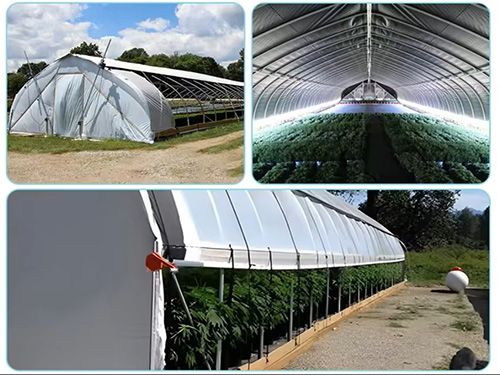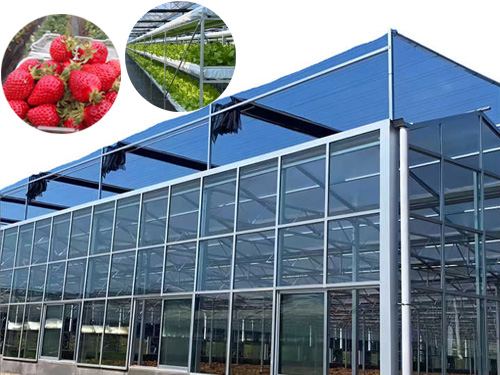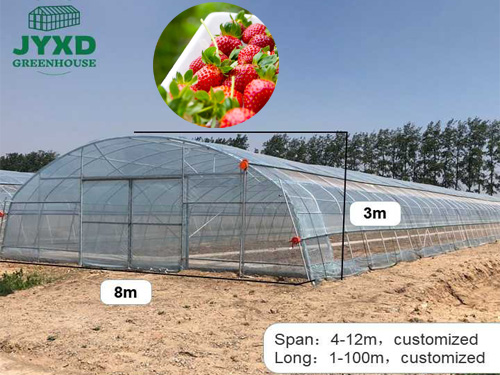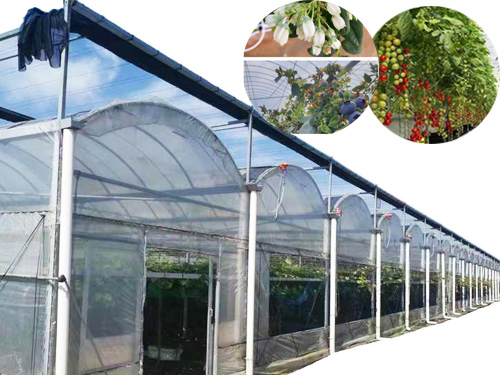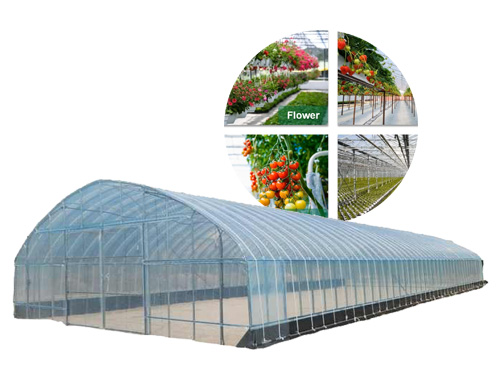NEWS DETAILS
NEWS INFORMATION
Setting Up an Effective Greenhouse Ventilation System to Prevent Disease
AUTHOR:jyxd-greenhouse DATE:2025-03-19 10:37:18 HITS:179
A properly ventilated greenhouse is crucial for maintaining healthy plant growth and preventing the spread of diseases. Without an effective ventilation system, greenhouses can become breeding grounds for harmful pathogens, such as fungi, bacteria, and mold. These pathogens thrive in the warm, humid environment that greenhouses often create. In this article, we will explore the importance of greenhouse ventilation, common types of ventilation systems, and tips for setting up an efficient system to prevent disease and ensure a healthy growing environment.
1. The Importance of Greenhouse Ventilation
Ventilation plays a vital role in regulating temperature, humidity, and airflow inside a greenhouse. Without proper ventilation, the greenhouse environment can become overly humid and stagnant, creating ideal conditions for the growth of mold, mildew, and other pathogens. Adequate ventilation helps to:
• Control Humidity Levels: High humidity can cause excess moisture on plant surfaces, promoting fungal growth and other plant diseases. Proper airflow helps to keep humidity levels in check and prevent disease.
• Regulate Temperature: Ventilation helps regulate the greenhouse temperature by allowing hot air to escape and cooler air to enter. This creates a more stable environment, which is essential for plant health.
• Improve Air Circulation: Good airflow helps distribute carbon dioxide (CO2) evenly throughout the greenhouse, improving plant growth and reducing the risk of fungal infections caused by stagnant air.
By setting up an effective ventilation system, you can prevent these issues, promoting a healthy and productive greenhouse environment.
2. Types of Greenhouse Ventilation Systems
There are several types of ventilation systems commonly used in greenhouses. Each system has its benefits, depending on the size, design, and location of your greenhouse.
Natural Ventilation
Natural ventilation relies on passive airflow created by wind and temperature differences inside and outside the greenhouse. This system typically includes vents at the roof and sides of the greenhouse, which open and close to allow air to circulate. Natural ventilation is cost-effective and energy-efficient, making it ideal for smaller greenhouses. However, it may not be sufficient in areas with low wind speeds or high humidity, requiring supplementary ventilation methods.
Active (Mechanical) Ventilation
Active ventilation systems use fans to circulate air inside the greenhouse. These fans can be placed at various points, such as on the sidewalls or the roof, to push air through the greenhouse. This system is more reliable than natural ventilation, especially in larger greenhouses or locations with unpredictable weather. Active ventilation is also highly effective in controlling humidity levels and preventing the buildup of stagnant air.
Combination Ventilation
Some greenhouses use a combination of natural and active ventilation to maximize airflow and control both temperature and humidity. For instance, the greenhouse may use natural ventilation during cooler months, while fans are employed during hotter months to boost airflow. This hybrid approach can be especially beneficial in climates with variable weather conditions.
3. Setting Up a Greenhouse Ventilation System to Prevent Disease
To ensure the most effective ventilation system, there are several key factors to consider during the setup process. Proper planning and design can make a significant difference in disease prevention and overall plant health.
3.1. Size and Placement of Vents
The size and placement of vents are critical for effective ventilation. Roof vents, side vents, and louvered panels should be strategically positioned to allow for maximum airflow. The larger the vents, the more air can circulate, helping to reduce humidity and temperature buildup. Consider the following:
• Roof Vents: Place vents at the top of the greenhouse to allow hot air to rise and escape. Roof vents should be designed to open fully to promote air exchange.
• Side Vents: Side vents should be placed along the length of the greenhouse, allowing fresh air to enter. These vents should be adjustable to regulate airflow based on weather conditions.
• Louvered Panels: Louvered panels can be installed on the sidewalls to control the direction of airflow. These panels can be adjusted to increase ventilation during hot or humid conditions.
3.2. Installing Exhaust Fans
For greenhouses that require active ventilation, exhaust fans are a must. The fans should be strategically placed to pull hot, moist air out of the greenhouse while drawing in fresh, cooler air from outside. Consider the following when installing exhaust fans:
• Fan Size: Choose fans with the right capacity to move enough air based on the size of your greenhouse. Fans that are too small may not provide adequate airflow, while fans that are too large may cause excessive turbulence.
• Placement: Install exhaust fans on the leeward side of the greenhouse (the side opposite the prevailing wind direction) to ensure air is drawn through the structure efficiently. This helps create a balanced airflow, improving temperature control and reducing humidity levels.
3.3. Incorporating Shading Systems
In some regions, high temperatures combined with poor ventilation can lead to excessive heat buildup. This can stress plants and promote the growth of pathogens. Installing shading systems, such as shade cloths or retractable screens, can help reduce heat and light intensity, preventing overheating. Combined with proper ventilation, shading systems can improve air circulation while maintaining optimal growing conditions.
3.4. Monitoring and Adjusting Ventilation
To ensure the ventilation system is working effectively, it is essential to monitor greenhouse conditions regularly. This includes tracking temperature, humidity, and airflow levels to ensure they remain within the ideal range for plant health. You can use climate control systems and sensors to automate adjustments based on real-time data. Automated systems can open and close vents or activate fans depending on the conditions inside the greenhouse.
4. Benefits of Proper Ventilation in Disease Prevention
An efficient ventilation system plays a key role in disease prevention by creating an environment that is less favorable for pathogens. Proper airflow helps in the following ways:
• Reduces Excess Moisture: By promoting evaporation and removing humid air, ventilation prevents the buildup of moisture on plant surfaces, a common cause of fungal infections like powdery mildew and botrytis.
• Inhibits Mold Growth: Mold thrives in stagnant, humid environments. Good ventilation helps prevent mold buildup on plant leaves, soil, and surfaces.
• Improves Plant Resistance: Proper ventilation contributes to a healthier plant environment, which strengthens plant resistance to diseases. Stronger, well-maintained plants are less susceptible to infection and damage.
5. Conclusion
An effective greenhouse ventilation system is essential for controlling temperature, humidity, and airflow, all of which contribute to preventing plant diseases. Whether you opt for natural, active, or a combination system, it’s crucial to design the ventilation setup based on your greenhouse’s size, climate, and specific plant needs. Properly placed vents, exhaust fans, and automated climate control can help reduce disease risks, promote healthy plant growth, and increase overall productivity. By investing time and resources into an efficient ventilation system, you can create a thriving environment where your plants flourish while minimizing the risks of disease.
For more information on greenhouse ventilation systems, or if you need help setting up the right system for your greenhouse, feel free to reach out. We offer customized solutions to ensure your greenhouse operates at its best, promoting long-term success.
Hebei Juyou Xinda Greenhouse Facilities Co.,Ltd.
Copyright © 2024-2025 https://www.jyxd-greenhouse.com. All Rights Reserved Hebei Juyou Xinda Greenhouse Facilities Co.,Ltd.Copyright





 Current Location:
Current Location:


